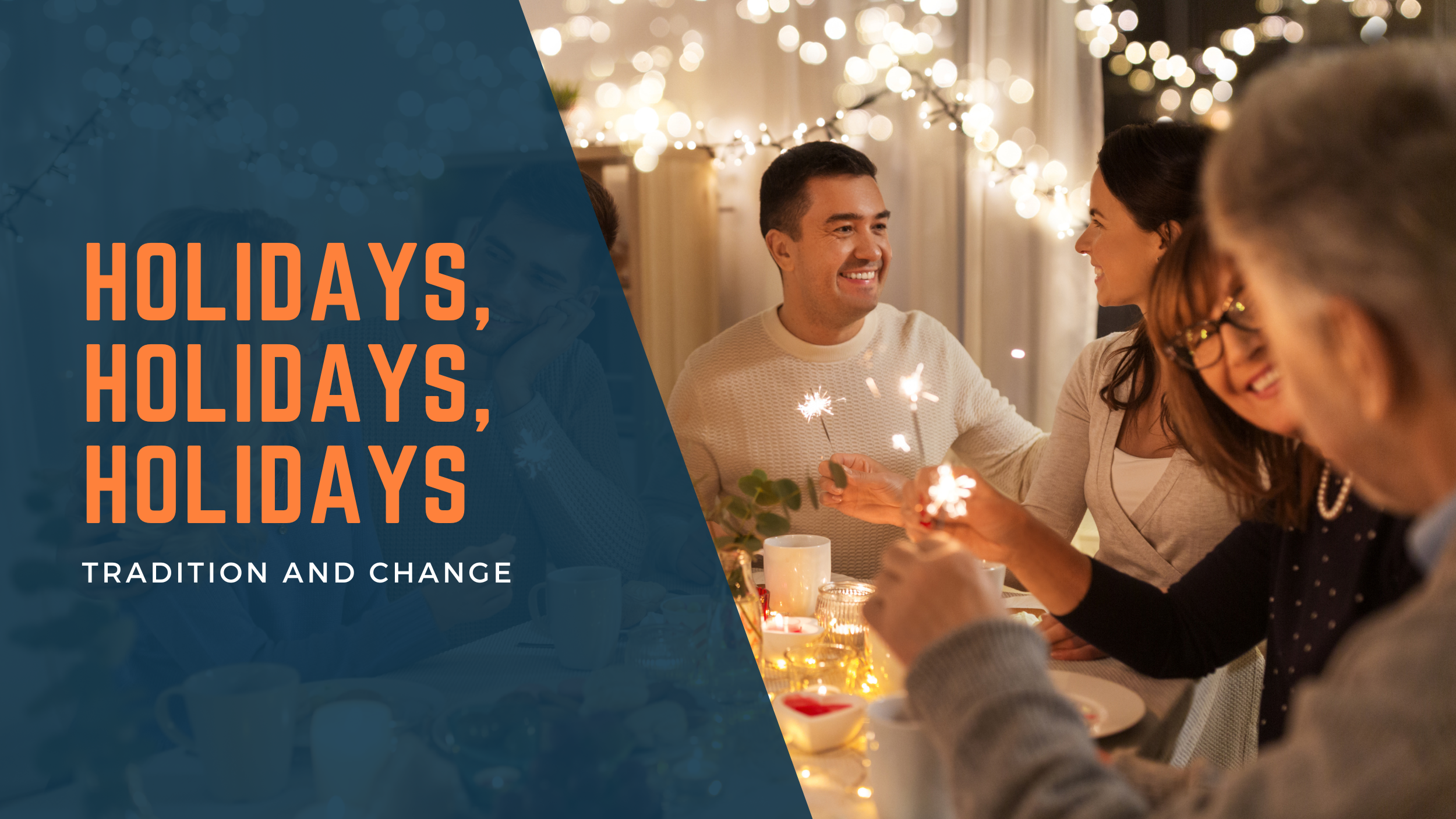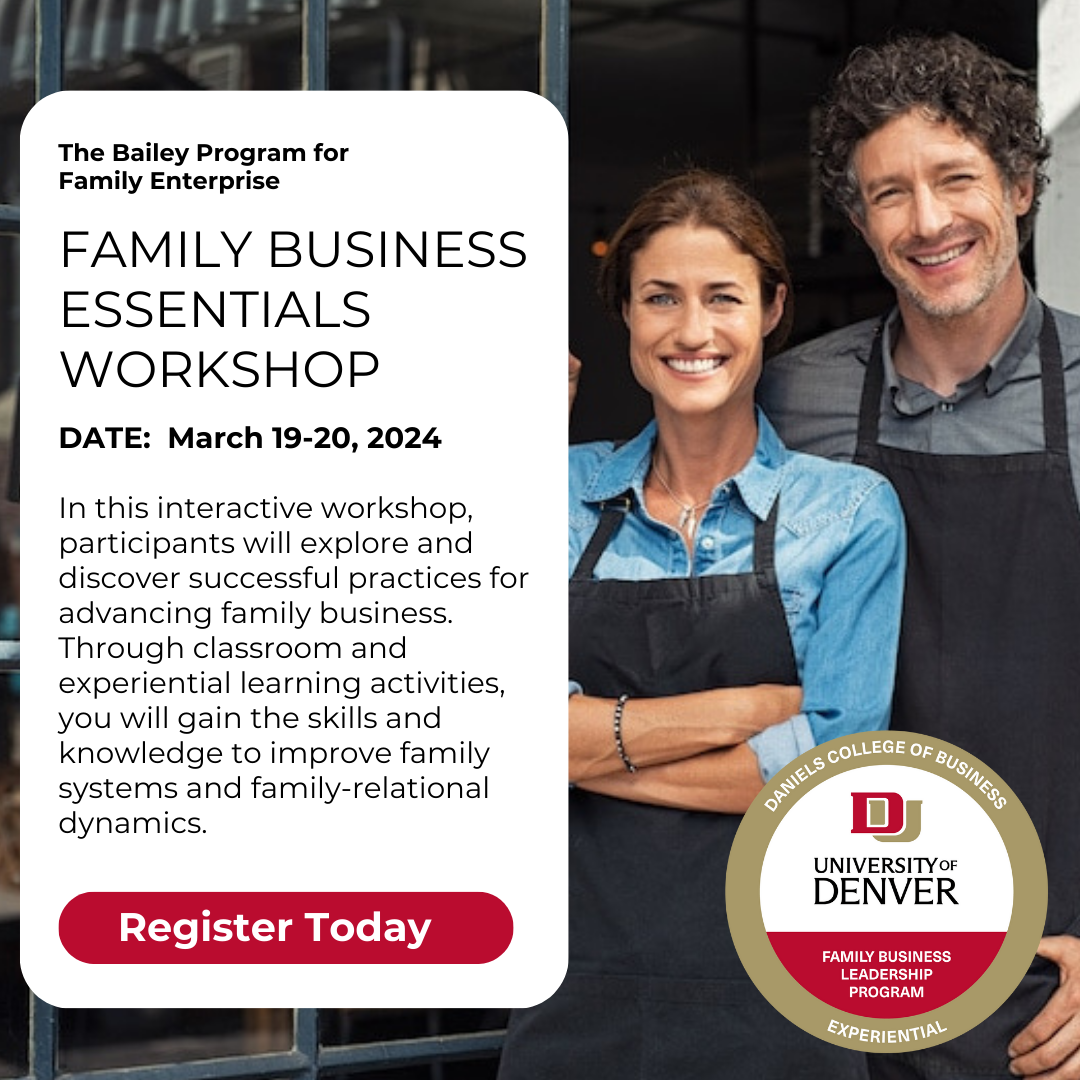It is that time of year again. Families will be spending time together for the holidays. These calendar events mix all ages. There will be parents, siblings,
grandparents, in-laws, significant others, and neighbors in proximity for sharing food, fun, frivolity and often frustrations. “I love the holidays and remember special times.”, “Do I have to see her?”, “Oh I can’t wait to see Bob, it’s been too long.” “I hope Sue brings her usual blueberry pie,” “Will that bratty cousin from California be there?” Okay, you get the idea. I bet you’ve been there.
And then there is the element of family enterprise. As is traditional, there will be talk about it. The new truck that was just bought, tension from the disagreement that took place 3 days before, excitement about an upcoming new office design, record profits, lost revenue, and even difficult employees. Some family members will be in the know and others will not. A particular decision may even be made on the purchase of production equipment. Does this sound like your tradition? Hopefully, you can minimize it.
Traditions provide comfort. They are the glue that holds us together. And when you work side by side with your family, sometimes it is easy to forget that you are relatives and not just co-workers or business partners. So, holidays are a time to reconnect with each other and remind everyone of familiness.
But sometimes traditions need to change. How that change takes place can have lasting impacts, either negative, positive and often some of both.
Below is an example of a situation from my own family. I wrote this to family members in response to a push for change in a tradition.
Christmas 2017
Ah yes, Christmas giving! As the story goes it all began with 3 Wise Men who decided to travel great distances to see a new King. Along the way, they thought it best to take some gifts to honor the infant and of course, please and gain favor with his parents. At first, there was friction among them as to what the gifts should be and what value they needed to have. They had a little gold but needed something more. Then the critical decision is where to get the other items. One of the Wise Men chose Walmart, and the other 2 chose Target. (Target had the best price on quality Frankincense and Myrrh). So off to Target they went, and the rest is history. 😉
Bear with me as I ramble more. The idea of giving to needy people, animals or causes is quite noble and important. There have been previous individual family members talking about just such an approach to Christmas off and on for many years. Now Ginger, Dale and Sam have “come out of the closet”. That’s good. They propose donating to important meaningful causes and not gifting to each other.
As the now senior member of the generations involved and the guy who professionally has dealt with these and much heavier family matters for 45 years, here are my thoughts.
Family tribal rules and traditions rarely change quickly. There can be a disruption and then re-alignment not unlike the natural ones that occur when the next generation takes over Thanksgiving dinner.
Disruptions make everyone think and that’s a good thing! In this case the thinking maybe, “What is all this Christmas present stuff about?” “We really don’t need it”. “What about less commercialism?” Others have so much less, we need to give to them instead etc. etc.
Gifting to each other at Christmas is a tradition for this family. Mom’s approach was that everyone was to get something from her no matter what – trinkets, toys, money, food (and yes pimento cheese). There was joy for her in that. Dad was disconnected from the giving thing, really. But his approach was more about something needed or useful.
Christmas morning at the Reece house growing up was chaotic as everyone got their gifts and quickly tore them open; often not knowing who the giver was other than Santa.
Joyce and Fred loved Christmas. Fred would laugh and say, “Packages with no name tag on them belonged to me”. The Ellis family Christmas Eve gift-giving was orderly and sharing. Everyone paid attention to each other’s haul. This is the tradition we have continued at our house. Although slow-paced for today’s world. I still find it pleasant and rewarding, even exciting at times.
Of course, there is the pressure before the holidays to find the gifts. (the Wise Men felt that too). The gifts given over the years have been useful, meaningful, obligatory, re-giftable, unique experiences (Falconry), silly (wire scalp stimulator for hair growth or even a chia pet) and replenishing (new clothes). If the path chosen now is to have no typical gifts at Christmas something important would be missing.
We have abundance. We are fortunate and privileged. It’s good to share that abundant energy with others and with each other as well. In this family we have never openly shared our charitable giving efforts with each other. So, let’s do that! Share the joy of extended generosity! Tommie and I give to various things year-round. And I am sure others do too, like Ginger and Dale taking in foster dogs.
Giving time, talent and treasure is part of life. The quiet joy and satisfaction of giving to others can be celebrated among us. We could even start a new tradition of an annual family collective contribution to an organization.
But without some gift-giving among us there would be something else missing for me. That something is the child fun I re-experience each year, the chance to do something like Mr. Haney gifts or a new book to Jerry because he likes to read or receiving a bubble wand that has led to so much more fun for lots of strangers, even. In addition, I am amazed at Katherine’s great personalized gift wrapping.
Christmas Eve tradition at our house is a gift of time, laughter, a great meal, and joy. Those are gifts Tommie and I give to each of you every year. The gift of your presence is what we receive.
So, this year let’s alter and add to the tradition. Ginger has challenged us. OK, let’s pick up the challenge and see how we can be celebratory with each other about giving to others. But to me it is not an either or but a both.
Tommie and I will give gifts as we always have. We will contribute beyond that to some need and joyfully share our extended giving efforts with all of you. There is no obligation for anyone to do the same, but I for one would still like to at least play Jason’s game (no pressure Jason). Maybe next year the “Chinese” gifting game however that works, drawing names or something even more creative.
Love, Ron
The 2017 Christmas was abundant and meaningful as we shared our extended giving and presents too. My brother adopted a retired circus elephant with a donation in our names. There was a video presented of family members going through the grocery store filling up carts with food to give to a local charity and more.
Our primary tradition of having a big Christmas Eve meal at my house and then gift giving has continued and will be the same this year, I am sure. Emphasis on extended giving is less prominent. The size of the group has dwindled with the loss of parents and other senior family members. Married nephews now spend the holidays with their own families or at their in-laws. We don’t have an operating business to talk about, but my brothers and I will likely talk about the real estate we have at some point. Most of all we will have a great time as usual then everyone will go their separate ways. We will do it again next year even if it takes a different form.
Managing adjustments in long-held traditions requires thoughtful communication and some family member leadership. Occasionally it may require some help from a family business consultant. Here is one more example from an article by my colleague Jean Meeks-Koch at Positively People.
Individualism Vs. Collectivism
“All for one, and one for all,” or should it be?
One thing that piques my curiosity is the belief that to be a strong multi-generational family enterprise, we must embrace the greater whole, sacrificing our own needs. Collectivism is the practice of giving a group priority over an individual. (Merriam-Webster.com, 2021). The phrase “All for one, and one for all,” popularized by the A. Dumas novel The Three Musketeers, is another example of Collectivism. Every decade since the early 1900s has seen an adaptation of Dumas’ novel, so possibly most of our multi-generational families have heard the battle cry, “all for one, and one for all.”
Or let’s shift to another famous collectivism quote dating back to 6th Century B.C. by storyteller Aesop, “United we stand, divided we fall.” So again, we see the cry for unity, solidarity, alliance, and groupism. And yes, groupism is a word meaning “the tendency to conform to the cultural pattern of a group at the expense of individualism and cultural diversity.” (Merriam-Webster. com, 2021).
With groupism, about what happens when the next generation perceive they will lose their individualism and cultural diversity. Like Fiddler on the Roof, when Tevye sings “Tradition,” there is a tug-of-war between what was and what can be. Individualism allows for moving from traditions that may no longer serve the collective family and creating a learning environment where family members feel safe exploring contrarian ideas and questioning the status quo. I am not saying that tradition has no place, and collectivism is outdated. I am proposing a way of igniting curiosity and engagement while savoring traditions and core values.
Legacy vs. Individual Identity
So how can families be both individualistic and collectivist? Let’s discuss one of the most challenging family times of the year, the holidays. Here is my favorite fictitious family, the Morgans. The Morgans are three generations deep, with all generations of good health and wealth. Together there are two founders in their late eighties, 12 G2s including six married-ins, and 24 G3s including four married-ins. In total, we have 38 family members who live within a 20-mile radius of each other. Of the 38 family members, 19 work in the family enterprise. It has been the tradition to incorporate significant holidays around the G1s and their wishes. The 2020 COVID Thanksgiving broke this tradition, and smaller nuclear family branches spent the holidays together. Mom and Dad joined the smallest family branch, enjoying an intimate and COVID safe Thanksgiving.
Brrrring! My phone is blowing up, it is October 6th, and I have a total of 10 text messages and five-voice messages from members of the Morgan Family. There is agitation, frustration, guilt, and shame in their voices. The issue is the same; no one wants to go back to the tradition of “all for one, and one for all” illustrious turkey dinner at Grandma and Grandpa’s house. The individualist branch affair that evolved in 2020 was magical; expressing the individualism within each branch created an intimacy the Morgans lost throughout the years.
Is “Either or…” the Only Way?
How can this be resolved to honor the past and create a new way of moving forward? Can family members be vulnerable and authentically share the importance of valuing each individual family branch and remain committed to the collective family enterprise? Would family members, especially the G2s, feel selfish by not wanting to be together at mom and dad’s home? Then sprinkle on some good old-fashioned guilt, “Mom and Dad sacrificed so much for us and have given us this amazing family enterprise, the least we can do is, be there for the holidays,” sound familiar?
I know you are wondering how this story played out for Thanksgiving 2021. Let me share our steps in this journey.
Step One: I asked each family branch to meet and answer the following questions, and then email me their responses:
- Share your favorite Thanksgiving experience. What makes it unique? What do you want to repeat in the future?
- What do you value most in the greater giant family oak tree, including the G1 solid trunk, each unique G2 branch, and the new G3 twigs growing off each main branch?
- If you had Aladdin’s lamp, and you had three wishes, what would you wish for this Thanksgiving season?
Step Two: I invited all family members to a video conference call, where I shared the answers to my questions by theming together each branch’s responses.
Step Three: I then divided participants into video conferencing break-out rooms into groups of six and one group of five. (Note: all family members were not able to attend). I gave each break-out room 30 minutes to discuss the findings and come up with a solution for Thanksgiving 2021. I asked that there be a facilitator, note-taker/ presenter, and a timekeeper for each group.
Step Four: All participants returned to the main session, where each group presenter shared their proposed solution.
Embracing “Both and…”
So how did it end? G1s gave an inspirational message on the power of creating solid branches and the joy they feel for each family member’s uniqueness. The Morgans unanimously agreed that the new tradition for the holidays would be called Holidays 2.0, where the emphasis would be on intimacy and connection within each family branch, and that G1s would rotate from one family branch to another as long as this was physically possible.
The last decision was to celebrate major holidays at the Annual Morgan Family Enterprise Retreat each year. Each day has a dedicated evening meal that represents each of their significant family “tradition” holidays. I suspect that one day, as the Morgans continue to prosper and grow, there will be the need to repeat this conversation and evolve into a Holidays 3.0.
Conclusion
As I reflect on the Morgans, I reflect on 38 individuals. Each one is unique with talents, strengths, and challenges. Breaking down decades of a holiday tradition respectfully and compassionately starts with four simple steps:
- Acknowledge what currently exists. What are the things that we anchor around, and why are these important to our legacy? What things are we holding onto that no longer have meaning? See if you can come to a consensus around these questions.
- Define the future state. What do gatherings look like as the family system continues to grow? What are we willing to try to do differently? Ask, what will the holidays look like in 2030? Be creative and empathetic to other family members’ needs.
- Alignment is how you move from Acknowledgement to your Defined Future State. Put together a plan that identifies your goals and states who will be doing what and why it is essential to that individual, nuclear family, or family branch. Clearly state the actions for the collective group. What if you had a Zoom dessert party? An early Zoom coffee visit? Or?
- Passionate performance is when you take a leap and try something different. Move your actions from above into reality. Is different a little scary? Yes! But if you don’t push the edge, you will never see a new way of being.
Life is not this or that; life can be a sprinkle of this and that, tradition and new, individualism and collectivism. What it takes is for someone to start the conversation from a place of curiosity and exploration. So, make this holiday season filled with discovery and delight.
Being together as a family is important. We need the connections. Jean and I hope you all have Happy and Meaningful Holidays and if adjustments are needed take the risk – communicate and lead. Reach out for assistance if you need it.
Ronald C. Reece, Ph.D. is a Consulting Psychologist Specializing in Family and Closely Held Business Consulting.
He can be found at
800 E. Washington St., Ste-C
Greenville, SC 29601
Phone 864-233-6648 fax (864) 233-3706,
email [email protected]; website www.ronreece.com



